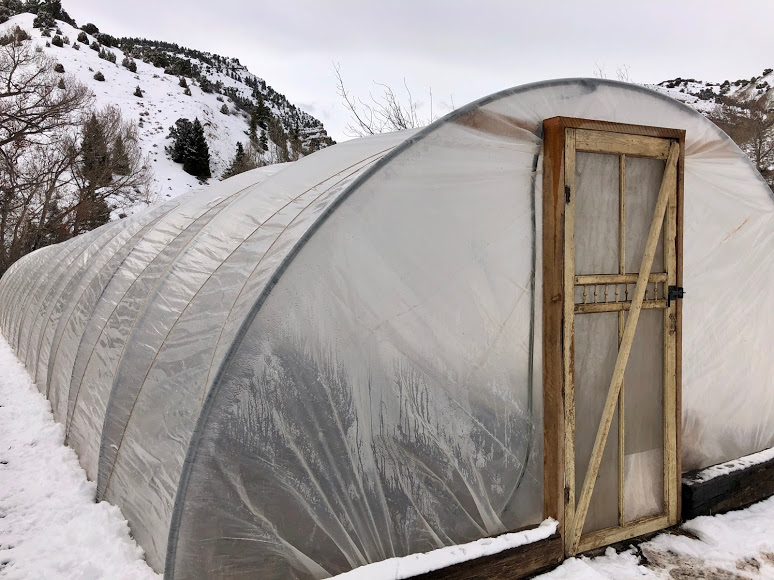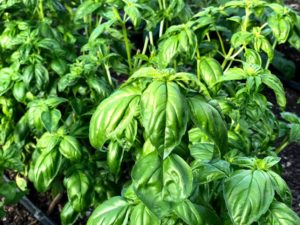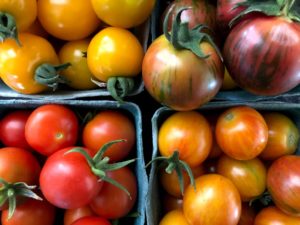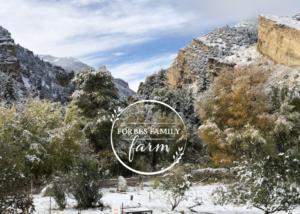What is a shoulder season exactly?
We are already ankle deep in the spring shoulder season. In our context, the shoulder seasons can best be described as the periods gradually entering or waking from the plant dormancy of winter. It’s an important time for market farmers and hobby gardeners alike. Shoulder seasons can vary significantly depending on your local climate. Some regions experience a very short and consistent shoulder season, meaning farmers can plan around reliable first or last frost dates. In other climates, like ours, the shoulder season is notoriously unpredictable, but also incredibly important for us to achieve our production goals.
The past two years highlight the unpredictability of our spring shoulder season. Last winter we did not develop a substantial base of snow, but from early March through late May we rarely experienced high temperatures above freezing and our low temperatures were regularly below 10 degrees. Small snow flurries seemed to pass through multiple times a week all the way through June 22. Snow never accumulated in a significant amount, but the persistent cold made it seem the shoulder season was simply an extension of winter that took us all the way to summer.
This year, we developed a substantial base of snow through the winter, several feet in places, and it contributed to ground frost that extended just as deep underground. But, in the final days of February the sun seemed to shine a little brighter and temperatures climbed. Now, a week and a half into March, we are fully immersed in the spring shoulder season. The combination of rapidly melting snow, thawing ground, and even a small rain storm causes only one thing…mud, and lots of it! It’s why we (not so) affectionately refer to this time of year as “Mud Season.”
Given this context, we want to share a few thoughts on two topics related to the shoulder season. First, why do we even worry about the shoulder season? Wouldn’t it be better to simply wait until the last frost like most seed packets recommend? Second, how do we deal with the shoulder season? What strategies work for getting crops off on the right foot and extending the harvest for as long as possible?
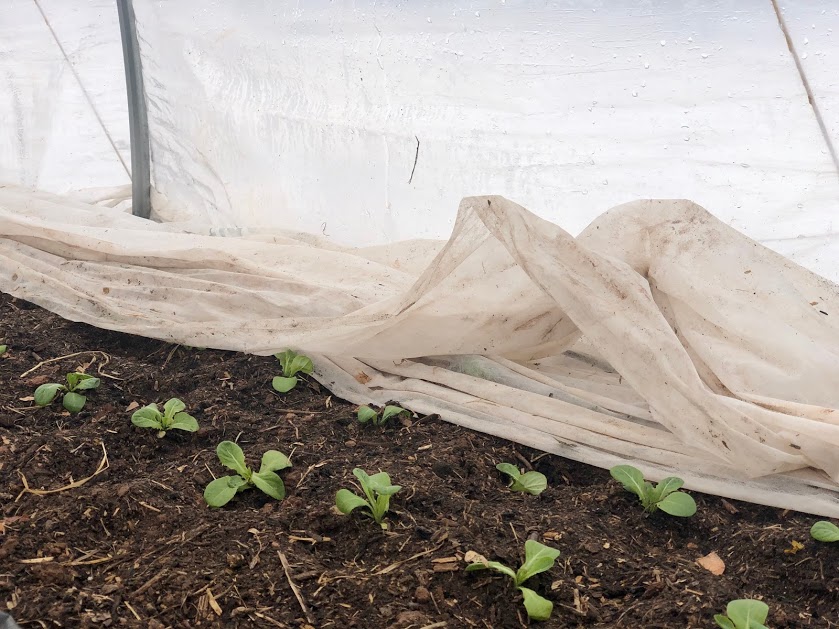
Why, is always a great question
And, it’s one we hear a lot regarding our farming practices. Why are you putting up these greenhouse things? Why do you move your chickens around all the time? Why do you use electric fencing? Why are all of your garden beds so close together? And that doesn’t even begin to account for all of the “why don’t you” questions. How, what, and when questions usually have pretty straightforward answers, but why questions really get to the heart of the values and logic underlying our decisions. So, why do we care about season extension?
There are two angles from which we view season extension as an important part of our operation. First, we view ourselves as modern homesteaders. We’re not looking to fall entirely off the grid and live in a dugout, but we do want to provide as much as we can for ourselves, especially as it pertains to food. Until the original homesteaders of the late 19th and early 20th centuries, the region we live in was home to nomadic tribes. The reason they were nomadic is because there are times of the year (i.e. winter) during which the area is not inhabitable. Modern technologies make it possible to live here year round, but they don’t change the fact that you cannot grow or find food for a large portion of the year. As a few ranchers in the area like to joke, this region really only has two seasons. Half of the year is spent trying to survive winter, and the other half of the year is spent stockpiling so you have some hope of surviving next winter. We will always have a few months in which we are dependent on storage from last season’s bounty, but the more we are able to take advantage of the shoulder season, the better we are able to meet our goal of providing for ourselves.
Our second “why” for making the most of the shoulder season relates to our role in the business of farming. We grow direct market produce, and a key to our success as market farmers is providing a product our customers like and cannot otherwise find. Sometimes that means growing unique varieties not usually found on the shelves of a grocery store. But, sometimes it simply means growing a familiar crop at a time when it is difficult to find fresh. A batch of ripe tomatoes a full month before any are ripening in our customers’ gardens is a big deal. It meets a need, especially in a community where it is difficult to access high-quality fresh produce, and it generates interest in our products.
So, we have personal and business interests contributing to our why for concerning ourselves with optimizing the shoulder season. And, while season extension is something humans have been doing since the dawn of the agricultural revolution, we are fortunate to have many tools and technologies making it easier and more productive.
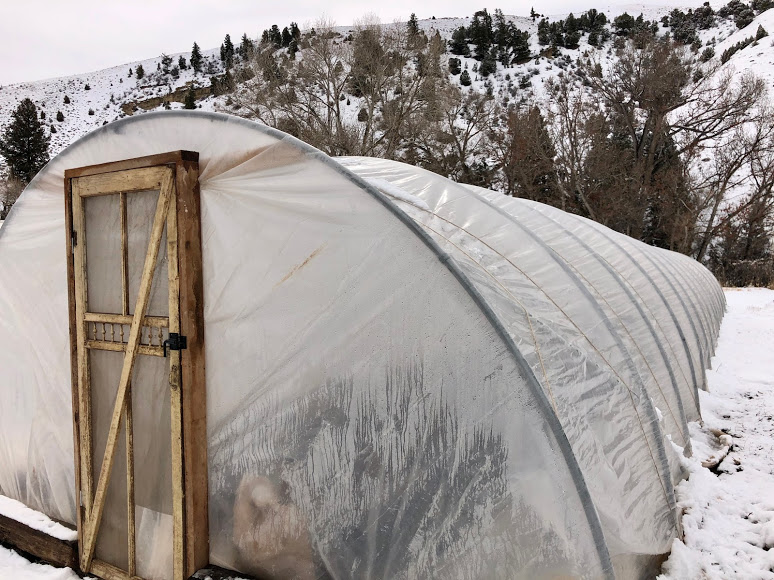
How we farm during the shoulder seasons
There are many strategies to season extension, but in our operation we try to think of it as having three components. Observing and interacting with the natural environment to optimize microclimates, creating microclimates, and effective crop planning.
Observing and interacting with the natural environment speaks to the idea that humans have been trying to extend (or optimize) growing seasons for thousands of years. Any piece of land will have microclimates. Heck, even an urban patio will have shady spots and sunny spots. Identifying the natural tendencies of an ecosystem, regardless of size, improves your ability to optimize crop production. We live in a canyon, so our property has incredible diversity of microclimates, ranging from shady riparian areas that hardly see the sun most of the year and are always cool, to the other extreme of south facing sandstone cliffs hospitable to little more than desert cactus. Having observed our property for an entire season we identified an area across a hay field from our primary gardens and house. This area receives significantly more sunshine during the shoulder seasons and is reasonably well protected from wind. As such, we added a hoop house and a new section of garden beds. Simply observing nature and designing strategically can go a long way in extending the season of your gardens.
The addition of a hoop house speaks to the next principle of creating microclimates. Landscape re-design and earthworks are one way of modifying the land to create microclimates, and there are some very interesting historic and modern examples of this. However, for most hobby gardeners or small farmers, it doesn’t make a lot of sense to create large earthworks in order to produce a few more vegetables. Fortunately, technological advances in the form of greenhouse plastics and row covers make it possible to create microclimates without significant cost. We believe the key point regarding season extension technology is to be conservative in your planning and spending.
There are a lot of ways to waste money and resources on a farm, and this is true when it comes to season extension, especially greenhouses. We are not here to say a fancy and permanent climate-controlled greenhouse is a bad investment. Quite the contrary, if you have a very clear business case and plan for use, a permanent greenhouse may be just what you need. But, we see a lot of empty, broken down, or mis-used greenhouses and high tunnels across the country (or at least the parts we’ve driven across). We cannot speak for all of them, but most of those situations probably stem from people buying or building structures without an appreciation for the work it takes to maintain them nor for the challenges associated with greenhouse growing.
Farming with hoop houses
All of our greenhouses are built in the traditional hoop house model with bows made of bent top-rail and greenhouse plastic stretched and secured either with cord or spring channel. The upfront investment for these structures was reasonable, substantially less than a permanent greenhouse, and, importantly, we have the ability to adjust and modify over time. After our first full season with the hoop houses, we identified a few design and location issues. Because the structures are not permanent, we were able to make changes to put one tunnel in a spot with more sun exposure and add doors so we can access the tunnels from the ends.
These types of adjustments would not be possible with a permanent greenhouse or even the much larger semi-permanent high tunnels promoted by some government agencies. Our recommendation to anyone interested in trying new technologies for season extension is to start small, reuse old materials when possible, and scale up in accordance with the demands of your customers or your learned experiences from prior years. For the home gardener, something as simple as a small cold frame constructed with old windows may be all that’s needed to add a few months of growing during the shoulder seasons.
Row covers are another valuable tool in our season extension arsenal. The row covers are usually made of woven fibers and can vary in weight. The highest quality row covers are water and UV penetrable and provide significant protection from frost damage. This means the covers can be placed directly over a seed bed, or even growing plants, and there is no need to remove them for the purpose of watering or to allow light in. Many of the cool season crops we grow in the spring grow all the way to maturity without ever having to remove a lightweight row cover. Our warm season crops benefit from a heavier weight cover in the late spring. This allows us to confidently transplant these crops before our last frost, giving them a head start and pushing their production earlier in the summer.
Finally, crop planning is a key piece to optimizing the shoulder seasons. Our efforts at optimizing and creating microclimates serve three purposes: growing cold hardy crops, extending the productive window for warm season crops, and growing cover crops to improve the health of our soils. Planning our crops and rotations around these concepts is critical. Simply having a hoop house doesn’t mean it makes sense to grow tomatoes all year round. Instead, we use the hoop houses and row covers to optimize production while staying in sync with the rhythms of nature’s seasons.

